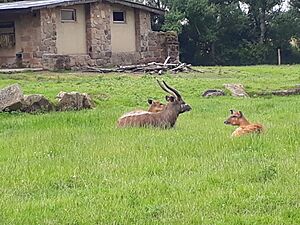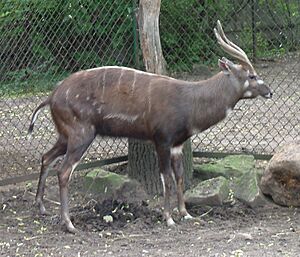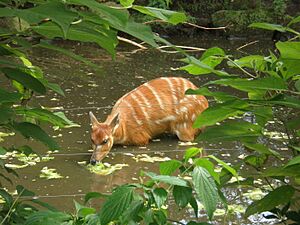Sitatunga facts for kids
Quick facts for kids Sitatunga |
|
|---|---|
 |
|
| A male at the Oji Zoo, Kobe, Japan | |
| Conservation status | |
| Scientific classification | |
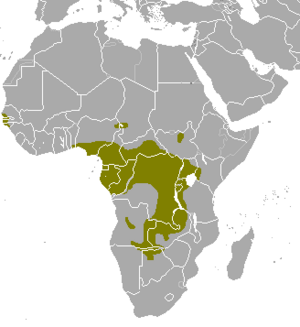 |
|
| The range map of sitatunga | |
| Synonyms | |
|
The sitatunga (Tragelaphus spekii), also known as the marshbuck, is a special kind of antelope. It lives in swamps and marshy areas across central Africa. You can find them in countries like the Democratic Republic of the Congo, Cameroon, Uganda, and Kenya.
Sitatungas love places with lots of tall, thick plants. They live in swamps that might dry up sometimes, marshy clearings in forests, and even mangrove swamps near rivers.
Contents
About the Sitatunga's Name and Family
The scientific name for the sitatunga is Tragelaphus spekii. An English explorer named John Hanning Speke first described this animal in 1863. He saw them near a lake in Tanzania. Speke called the animal "nzoé" (its local name) or "water-boc" because it looked a bit like a waterbuck. The name "sitatunga" comes from an old African language.
Even though Speke mentioned another scientist, Philip Sclater, in his book, Speke himself is officially recognized for describing the species first. The name T. spekii honors Speke.
The sitatunga belongs to the group of animals called Tragelaphus. This group is part of the Bovidae family, which includes cattle, goats, and sheep. Scientists have studied the DNA of different Tragelaphus species. They found that sitatungas are closely related to bongos, mountain nyalas, and bushbucks. In fact, sitatungas and bushbucks can even have babies together!
There are three main types, or subspecies, of sitatunga based on where they live:
- T. s. spekii: This is the Nile sitatunga, found near the Nile River.
- T. s. gratus: This is the Congo sitatunga, living in western and central Africa.
- T. s. selousi: This is the Southern sitatunga, found in southern Africa.
|
|||||||||||||||||||||||||||||||||||||||||||||||||||||||||||||||||||||||||||
| How the Sitatunga is related to other animals (based on DNA studies from 2005) |
What Sitatungas Look Like
Sitatungas are medium-sized antelopes. Males are much bigger than females. Males stand about 81 to 116 cm (32 to 46 inches) tall at the shoulder. They weigh about 76 to 119 kg (168 to 262 pounds). Females are smaller, about 72 to 90 cm (28 to 35 inches) tall and weigh 24 to 57 kg (53 to 126 pounds). Their tails are 14 to 37 cm (5.5 to 14.5 inches) long.
Only male sitatungas have horns. These horns are spiral-shaped with one or two twists. They can be quite long, from 45 to 92 cm (18 to 36 inches).
Their fur color changes depending on where they live. Young sitatungas are reddish-brown, and females are chestnut-colored. They have white markings on their face and faint stripes and spots on their body. Males' fur gets darker as they get older, turning gray to dark brown. Males also grow a shaggy mane and a white stripe down their back.
The sitatunga's body is perfectly designed for its swampy home. Their hooves are long and spread out wide, which helps them walk on soft, muddy ground without sinking. Their fur is shaggy and repels water, keeping them dry. They can lower their heads and bend their horns backward, which helps them move through thick plants easily. Their pointed toes allow them to walk quietly through the water.
Their coat color also helps them blend in with their surroundings, providing great camouflage. They have excellent hearing, which is very useful in dense swamps where it's hard to see far.
Sitatunga Life and Habits
Sitatungas are most active in the early morning, late evening, and at night. They spend a lot of this time eating. During the hottest part of the day, they rest in flat areas or among tall reeds. They usually stay in their swampy homes.
Sitatungas often live alone or in pairs. Sometimes, larger groups can be seen, but they don't interact much. Males usually stick with other males, and females with other females.
Sitatungas don't have territories like some other animals. Males might lock horns with each other or use their horns to hit plants. If they feel threatened, they might lift their front legs while keeping their back legs on the ground.
They communicate by touching noses, licking each other, or nibbling. If a sitatunga is scared, it might stand still with its head held high and one leg raised. They sometimes make coughing or barking sounds, especially at night. These sounds can travel far across the swamp and might be a warning to others. Males often make a low bellow when they see a female during mating season. Mothers use bleats to call their babies.
Sitatungas are good swimmers. They stay in areas with lots of plants to hide from predators like crocodiles. If they are bothered by flies or chased by predators, they can even submerge themselves in the water, leaving only their nose and eyes above the surface. This is why they are called "aquatic antelopes." After swimming, they often dry themselves in the sun. Other predators include lions, wild dogs, and leopards.
What Sitatungas Eat
Sitatungas are picky eaters and eat a mix of plants. They mostly eat new leaves, fresh grasses, and sedges (grass-like plants). Some of their favorite plants include bullrushes and various aquatic grasses. Their diet can change with the seasons, especially when water levels in the swamps change. Like the gerenuk, a sitatunga might stand on its back legs to reach higher branches or even use its horns to pull branches down.
Studies have shown that sitatungas eat many different plant species. They might even eat crops like sweet potatoes if they are available. When floods happen, sitatungas might move from the reed beds to flooded grasslands to find food.
Sitatunga Reproduction and Life Cycle
Female sitatungas can have babies when they are about one year old. Males are ready to mate when they are about one and a half years old. Sitatungas can breed all year round. When females gather, males will compete to mate with them.
Pregnancy lasts for about eight months, and usually, one calf is born. Calves are born throughout the year, but more often during the dry season. Mothers hide their calves very well and only bring them out when other sitatungas are around. A mother will look and nod at her calf to call it for nursing. Calves stay with their mothers even after a new calf is born. Mothers nurse their calves for about six months.
Young sitatungas take time to learn how to walk in the swampy environment. They often lose their balance and fall into the water. In captivity, sitatungas can live for about 22 to 23 years.
Where Sitatungas Live
The sitatunga is an "amphibious" antelope, meaning it can live both on land and in water. It lives only in swampy and marshy areas. They prefer tall, dense plants in swamps that are always wet or sometimes dry up. They also live in marshy clearings in forests, thickets along rivers, and mangrove swamps.
Sitatungas create clear paths in their swampy homes, often leading to areas with tall reeds. These paths can be wide and lead to feeding grounds or nearby forests. They usually stay in small areas close to water. In savannas, they are found in areas with papyrus and reeds.
Sitatungas are native to many African countries, including Angola, Botswana, Cameroon, the Democratic Republic of the Congo, Kenya, and Zambia. They are no longer found in Niger and are thought to be gone from Togo because their habitat has been taken over by people. While they are rare in western Africa, they are still common in the forests of central Africa and some swampy areas in central, eastern, and southern Africa.
Threats and Protecting Sitatungas
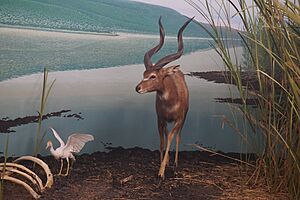
The biggest danger to sitatungas is the loss of their habitat. Wetlands are disappearing, which means sitatunga populations are becoming separated. Changes in water levels also affect the plants they eat. Large areas of swamps are burned every year, which is very dangerous for sitatungas because swamps can catch fire easily.
The International Union for Conservation of Nature (IUCN) lists the sitatunga as "Least Concern". This means they are not currently in great danger of disappearing. They are also protected under Appendix III in Ghana, which helps control their trade.
In some places like Senegal, hunting and habitat loss have made sitatungas very rare. In Gambia, they are now only found in a few hard-to-reach swamps. However, Botswana still has a large number of sitatungas, and hunting them for trophies is important for the local economy there.
It's hard to know exactly how many sitatungas there are because their habitat is so difficult to access. In 1999, an expert estimated about 170,000 sitatungas, but this might be too high. Their numbers are going down in areas where many people live, but they are stable in other places.
About 40% of sitatungas live in protected areas. These include places like the Okavango Delta in Botswana, Dja Faunal Reserve in Cameroon, and Salonga National Park in the Democratic Republic of the Congo. However, not all of these protected areas are well-managed.



